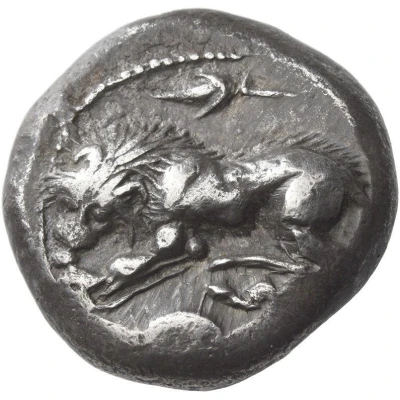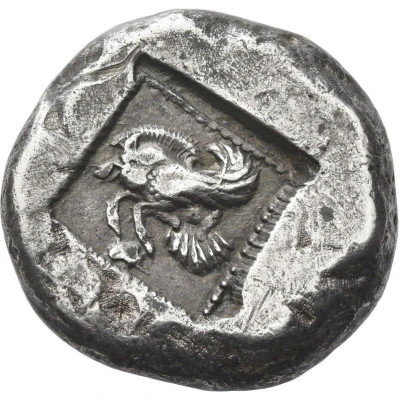


Tetradrachm 520 BC - 480 BC
| Silver | 17.16 g | - |
| Issuer | Uncertain Thraco-macedonian city (Thraco-macedonian region) |
|---|---|
| Type | Standard circulation coin |
| Years | 520 BC - 480 BC |
| Value | Tetradrachm (4) |
| Currency | Drachm |
| Composition | Silver |
| Weight | 17.16 g |
| Shape | Round (irregular) |
| Technique | Hammered, Incuse |
| Demonetized | Yes |
| Updated | 2024-10-10 |
| Numista | N#387560 |
|---|---|
| Rarity index | 100% |
Reverse
Forepart of a winged boar left, within a dotted square border within an incuse square.
Comment
Svoronos, Hellenism Primitif 8a and pl. XVII, 18 (this obverse) and 20 (this reverse die). Traité 1858 and pl. LIX, 14 var. (boar right). B.V. Head, Archaic Coins probably of Cyrene, NC 1891, p. 9, pl. I, 8. Weber 8555 var. (boar right). Jameson 2028 var. (boar right).
This extremely rare tetradrachm still remains somewhat of a mystery. It is tentatively treated as a possible Thraco-Macedonian tribal issue, largely on the basis of the lion type, which has some similarity to early electrum issues that seem to have been produced in Thrace, and the placement of the lotus ornament, which may echo issues of Akanthos. On the other hand, the winged boar might seem to hint of an origin in Asia Minor, where it was an important type for the coinage of Klazomenai. Far less likely is an origin in Cyrene, as was originally suggested when the coin was first published by B. V. Head in 1891.
Interesting fact
One interesting fact about this coin is that it features an image of a satyr, a mythical creature with the upper body of a man and the lower body of a goat, on the obverse (front) side. This suggests that the coin may have been used in religious or cultural ceremonies, as the satyr was a symbol of fertility and prosperity in ancient Greek mythology.